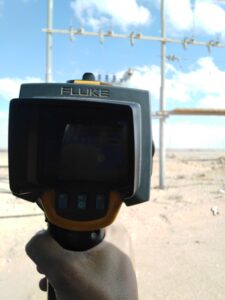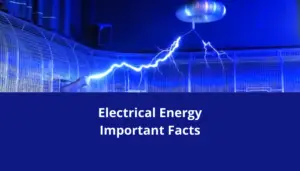I work as an electrical maintenance engineer. Our team is responsible for the maintenance of almost all electrical equipment types. Low voltage and medium voltage equipment.
The number one priority is to prevent the faults before they happen. To do this, we apply a preventive maintenance program for all electrical equipment. Let’s discuss what is electrical maintenance.
Table of Contents
What is Electrical maintenance?
Electrical maintenance refers to the regular inspection, repair, and upkeep of electrical systems, equipment, and infrastructure to ensure they operate safely, efficiently, and reliably.
It involves tasks like testing, troubleshooting, cleaning, and replacing components to prevent breakdowns and maintain electrical systems functionality.
Electrical maintenance is essential to prevent electrical failures, ensure safety, and extend the lifespan of electrical systems and equipment.
It involves regular checks, testing, cleaning, and repair to keep everything in optimal working condition.
Proper electrical maintenance is crucial in various settings, from homes and offices to industrial facilities and power plants.
What do we need for electrical maintenance?

Alternatively, we might inquire, “What tools are essential for electrical maintenance?” In the course of my work, I rely on a variety of tools designed for electrical maintenance. Here is a list of some of the tools we use:
-
Hand Tools: These include cable cutters, insulated pliers, insulated screwdrivers, hacksaws, spanners, wire strippers, and hammers.
-
Measurement Devices: We utilize instruments like AVO meters, insulation resistance testers (megger testers), and grounding resistance measurement devices to assess electrical parameters.
-
Testing Devices: For testing purposes, we employ tools such as transformer oil breakdown voltage testers, circuit breakers and overload testers, and transformer turns ratio testers.
-
Additional Maintenance Equipment: This category encompasses equipment like transformer oil filtration units, thermal imaging cameras, and vacuum cleaners used for panel cleaning.
-
Maintenance Software: We also rely on computerized programs like MAXIMO and ORACLE maintenance to manage and organize our maintenance activities effectively.
These maintenance tools and equipment play essential roles in our electrical maintenance tasks. Each specific task may require a particular set of tools and devices, so it’s crucial to ensure you have the necessary equipment prepared before beginning any maintenance work.
Maintenance types
Electrical maintenance encompasses various types of activities aimed at ensuring the proper functioning, safety, and reliability of electrical systems and equipment. Here are some common types of electrical maintenance:
-
Corrective Maintenance:
- Description: Corrective maintenance, also known as “breakdown maintenance” or “reactive maintenance,” involves repairing or replacing equipment after it has failed or malfunctioned. It aims to restore equipment to working condition.
- Example: When a machine in a manufacturing plant stops working unexpectedly, technicians are called in to diagnose and fix the issue. This type of maintenance is often costly and can result in downtime.
-
Preventive Maintenance:
- Description: Preventive maintenance is a proactive approach that involves regularly scheduled inspections, servicing, and repairs to prevent equipment failures. It aims to keep equipment operating efficiently and extend its lifespan.
- Example: Changing the oil in a car engine every 5,000 miles to prevent engine damage and maintain performance is a form of preventive maintenance.
-
Predictive Maintenance:
- Description: Predictive maintenance uses data and condition monitoring to predict when equipment is likely to fail. By analyzing trends and data, maintenance can be scheduled just in time to address issues before they become critical.
- Example: In the aviation industry, sensors on aircraft engines continuously monitor engine performance. Data is analyzed to predict when specific components might fail, allowing airlines to schedule maintenance before a major issue occurs.
-
Condition-Based Maintenance:
- Description: Condition-based maintenance relies on real-time monitoring and data analysis. Maintenance actions are triggered based on the actual condition of the equipment, which is continuously monitored. This approach reduces unnecessary maintenance and minimizes downtime.
- Example: In a data center, temperature and humidity sensors are used to monitor the conditions of server rooms. If temperature levels rise above a specified threshold, air conditioning maintenance is scheduled to prevent overheating and equipment damage.
Each type of maintenance has its advantages and disadvantages. Corrective maintenance can be costly and result in downtime, while preventive maintenance can be expensive due to frequent servicing.
Predictive and condition-based maintenance aim to strike a balance by reducing unnecessary maintenance actions and ensuring equipment reliability.
The choice of maintenance strategy often depends on factors such as equipment criticality, cost considerations, and the availability of monitoring technology.
The choice of which type of electrical maintenance to perform depends on factors such as the type of equipment, its criticality to operations, budget constraints, and safety considerations.
An effective maintenance strategy often combines several of these types to ensure the reliability and longevity of electrical systems and equipment.
Find out more details about Why Is Electrical Maintenance Important?
Maintenance strategies
Maintenance strategies are approaches used to manage and maintain assets and equipment in various industries. These strategies help organizations ensure the reliability, availability, and performance of their assets. Here are several maintenance strategies:
-
Reactive Maintenance (Run-to-Failure):
- Involves fixing equipment only after it fails or malfunctions.
- Suitable for non-critical assets where downtime and repair costs are low.
- Example: A lightbulb replacement when it burns out.
-
Preventive Maintenance:
- Scheduled and routine maintenance performed at regular intervals.
- Aims to prevent equipment failures and extend asset lifespan.
- Example: Changing the oil in a car every 5,000 miles.
-
Predictive Maintenance:
- Uses data and condition monitoring to predict when equipment is likely to fail.
- Maintenance is scheduled just in time to address issues before they become critical.
- Example: Monitoring equipment vibration levels to detect potential bearing failures.
-
Condition-Based Maintenance:
- Maintenance actions are triggered by real-time equipment condition monitoring.
- Reduces unnecessary maintenance and minimizes downtime.
- Example: Monitoring temperature and humidity in server rooms and scheduling HVAC maintenance when needed.
-
Reliability-Centered Maintenance (RCM):
- A systematic approach that determines the most efficient and effective maintenance strategy for each asset.
- Evaluates the criticality of each asset and its potential failure modes.
- Example: RCM might recommend different maintenance strategies for critical versus non-critical equipment.
-
Total Productive Maintenance (TPM):
- Focuses on maximizing overall equipment efficiency and minimizing downtime.
- Involves employees in maintenance activities and emphasizes preventive measures.
- Example: Regularly cleaning and inspecting machinery to prevent breakdowns.
-
Proactive Maintenance:
- A combination of preventive and predictive approaches.
- Addresses root causes of failures and aims to eliminate them.
- Example: Identifying and fixing recurring issues in a manufacturing process.
-
Run-to-Obsolete Maintenance:
- Equipment is maintained until it becomes obsolete or no longer serves its purpose.
- Common for non-critical assets with a limited lifespan.
- Example: Maintaining legacy computer systems until they are replaced.
-
Run-to-Repair Maintenance:
- Equipment is maintained until it breaks down, then repaired or replaced.
- Common for assets with low replacement costs.
- Example: Residential appliances like toasters or coffee makers.
-
Risk-Based Maintenance (RBM):
- Prioritizes maintenance based on the assessed risk associated with equipment failure.
- Focuses on assets with the highest risk and potential consequences.
- Example: Aircraft maintenance where safety-critical systems are carefully monitored and maintained.
Organizations choose maintenance strategies based on factors like asset criticality, cost considerations, industry regulations, and the available technology and resources. Effective maintenance strategies aim to balance reliability, cost-efficiency, and asset longevity.
Read also my comprehensive article, How Many Types of Electrical Maintenance?
difference between maintenance type and strategy
The terms “maintenance type” and “maintenance strategy” are related concepts in the field of asset management and maintenance, but they refer to different aspects of managing and maintaining assets. Here’s the key difference between them:
Maintenance Type:
- A maintenance type refers to the specific category or approach used to address maintenance needs for equipment or assets.
- It primarily categorizes maintenance activities based on their nature and timing.
- Maintenance types include Corrective Maintenance, Preventive Maintenance, Predictive Maintenance, and Condition-Based Maintenance, among others.
- Maintenance types focus on the “how” of maintenance activities and describe the nature of the maintenance tasks performed.
Maintenance Strategy:
- A maintenance strategy is a broader and more comprehensive plan or approach used to manage and optimize maintenance activities for an organization’s assets.
- It outlines the overall approach and methodology for maintaining assets, considering factors like asset criticality, cost, and reliability goals.
- Maintenance strategies encompass multiple maintenance types and may involve a combination of approaches tailored to specific assets or asset classes.
- Maintenance strategies focus on the “why” and “when” of maintenance activities and provide a framework for decision-making regarding asset management.
In essence, maintenance types are specific methods or approaches for performing maintenance tasks, while maintenance strategies are higher-level plans that guide an organization’s overall approach to asset maintenance.
Maintenance strategies often involve selecting and implementing appropriate maintenance types based on the organization’s goals, resources, and the nature of its assets.
electrical maintenance work
Electrical maintenance work encompasses a range of tasks and activities aimed at ensuring the proper functioning, safety, and reliability of electrical systems and equipment. Here are some common electrical maintenance tasks:
-
Visual Inspection: Conducting visual inspections of electrical equipment and systems to identify any visible signs of wear, damage, or corrosion. This includes checking for loose connections, frayed wires, and signs of overheating.
-
Cleaning: Removing dust, dirt, and contaminants from electrical components and connections. Clean equipment operates more efficiently and reduces the risk of electrical faults.
-
Lubrication: Applying lubricants to moving parts in electrical machinery, such as motors and generators, to reduce friction and prevent premature wear.
-
Testing and Measurement: Using specialized equipment to measure electrical parameters like voltage, current, resistance, and capacitance to ensure that circuits are operating within safe and specified limits.
-
Circuit Breaker Testing: Regularly testing circuit breakers to ensure they function correctly and can interrupt electrical currents in case of overloads or faults.
-
Grounding and Earthing Checks: Ensuring that grounding and earthing systems are in place and functioning correctly to prevent electrical shock hazards and maintain safety.
-
Calibration: Calibrating measuring instruments and sensors to ensure accuracy in electrical measurements.
-
Component Replacement: Replacing worn-out or damaged components, such as fuses, circuit breakers, switches, and wiring, to maintain the integrity of the electrical system.
-
Insulation Resistance Testing: Checking the insulation resistance of electrical cables and wires to ensure they are not compromised, which could lead to short circuits or electrical faults.
-
Thermal Imaging: Using thermal imaging cameras to detect hotspots or overheating in electrical equipment, can indicate potential issues.
-
Power Quality Analysis: Monitoring and analyzing power quality parameters, such as voltage fluctuations and harmonics, to ensure a stable and reliable electrical supply.
-
Emergency Repairs: Responding to electrical system failures or malfunctions promptly to minimize downtime and restore normal operation.
-
Safety Checks: Ensuring that safety features, such as safety switches, ground fault circuit interrupters (GFCIs), and surge protectors, are functioning correctly to protect against electrical hazards.
-
Documentation: Maintaining detailed records of maintenance activities, repairs, and inspections for future reference and compliance with regulatory requirements.
-
Energy Efficiency Audits: Identifying opportunities for improving energy efficiency in electrical systems and implementing measures to reduce energy consumption.
-
Upgrades and Modernization: Planning and implementing upgrades to electrical systems and equipment to improve performance, safety, and compliance with current standards.
-
Software and Control System Maintenance: Maintaining and updating software programs and control systems that manage electrical processes and automation.
Electrical maintenance work is essential in various settings, from homes and commercial buildings to industrial facilities, power plants, and infrastructure projects.
Regular and proactive maintenance helps prevent unexpected failures, ensures safety, and extends the lifespan of electrical systems and equipment.
Electrical maintenance work list
Certainly, here’s a table listing various electrical maintenance tasks:
| Electrical Maintenance Task | Description |
|---|---|
| Visual Inspection | Visually examine equipment for signs of wear, damage, or loose connections. |
| Cleaning | Remove dust, dirt, and contaminants from electrical components and connections. |
| Lubrication | Apply lubricants to moving parts in electrical machinery to reduce friction and wear. |
| Testing and Measurement | Measure electrical parameters like voltage, current, resistance, and capacitance. |
| Circuit Breaker Testing | Test circuit breakers to ensure they function correctly in case of overloads or faults. |
| Grounding and Earthing Checks | Verify that grounding and earthing systems are functioning correctly for safety. |
| Calibration | Calibrate measuring instruments and sensors for accurate electrical measurements. |
| Component Replacement | Replace damaged or worn-out components, including fuses, circuit breakers, and switches. |
| Insulation Resistance Testing | Check the insulation resistance of cables and wires to prevent short circuits or electrical faults. |
| Thermal Imaging | Use thermal imaging cameras to detect hotspots or overheating in electrical equipment. |
| Power Quality Analysis | Monitor and analyze power quality parameters for a stable and reliable electrical supply. |
| Emergency Repairs | Respond promptly to electrical system failures to minimize downtime and restore normal operation. |
| Safety Checks | Ensure safety features like safety switches and GFCIs are functioning correctly for safety. |
| Documentation | Maintain detailed records of maintenance activities, repairs, and inspections for reference. |
| Energy Efficiency Audits | Identify energy efficiency opportunities and implement measures to reduce energy consumption. |
| Upgrades and Modernization | Plan and implement upgrades to improve performance, safety, and compliance with standards. |
| Software and Control System Maintenance | Maintain and update software programs and control systems for effective electrical management. |
These tasks are essential for the proper functioning and safety of electrical systems and equipment in various settings.
Electrical maintenance equipment
Here’s a list of common electrical maintenance equipment and tools explained:
-
Multimeter:
- Description: A versatile tool for measuring voltage, current, and resistance in electrical circuits.
-
Insulation Resistance Tester:
- Description: Used to check the insulation quality of wires and cables, helping prevent short circuits and electrical faults.
-
Clamp Meter:
- Description: Measures current flow in a conductor without the need to disconnect it, making it convenient for troubleshooting.
-
Oscilloscope:
- Description: Displays electrical waveforms, helping diagnose complex circuit issues and waveform abnormalities.
-
Circuit Tester:
- Description: Determines the presence of voltage in a circuit or electrical outlet, ensuring safety during maintenance.
-
Phase Rotation Tester:
- Description: Identifies the sequence of phases in three-phase power systems, ensuring proper connections.
-
Megohmmeter (Megger):
- Description: Measures high-resistance values in electrical insulation, helping maintain insulation integrity.
-
Ground Resistance Tester:
- Description: Measures the resistance of grounding systems, crucial for electrical safety and lightning protection.
-
Infrared Thermometer:
- Description: Measures temperature and detects hotspots in electrical equipment, identifying potential issues.
-
Thermal Imaging Camera:
- Description: Captures thermal images to visualize temperature variations and overheating components.
-
Voltage Tester (Voltage Detector):
- Description: Safely checks for the presence of voltage without direct contact, ensuring safety during testing.
-
High-Potential (Hipot) Tester:
- Description: Tests the insulation and dielectric strength of electrical devices, ensuring their safety and reliability.
-
Power Quality Analyzer:
- Description: Monitors and analyzes electrical parameters to assess power quality and troubleshoot issues.
-
Cable Locator and Tracer:
- Description: Locates and traces electrical cables in walls, ceilings, or underground installations.
-
Wire Stripper and Crimper:
- Description: Removes insulation from wires and crimps connectors, essential for making secure electrical connections.
-
Cable Cutters:
- Description: Cuts and trims electrical cables and wires accurately.
-
Insulated Pliers:
- Description: Pliers with insulated handles for safe handling of wires and components.
-
Insulated Screwdrivers:
- Description: Screwdrivers with insulated handles to prevent electrical shock while working on live circuits.
-
Hacksaw:
- Description: Cuts metal conduit, pipes, or brackets in electrical work, facilitating installations and repairs.
-
Spanners and Wrenches:
- Description: Tightens or loosens nuts and bolts in electrical installations, ensuring secure connections.
-
Fish Tape:
- Description: Pulls wires through conduits, walls, and other tight spaces during installations.
-
Wire Labels and Markers:
- Description: Labels wires and cables for organization and easy identification in complex systems.
-
Electrical Safety Gear:
- Description: Includes gloves, safety glasses, helmets, and protective clothing to protect against electrical hazards.
-
Tool Bags and Toolboxes:
- Description: Organizes and carries electrical maintenance tools and equipment for easy access and portability.
-
Lockout/Tagout (LOTO) Devices:
- Description: Locks and tags out electrical equipment during maintenance to prevent accidental energization and ensure safety.
These tools and equipment are indispensable for conducting electrical maintenance tasks effectively, safely, and with precision in various electrical systems and installations.
Install my Free Android App on Google Play:
Electrical Cables Most Common Tables “Electrical Cables Tables”
And, my Electrical Calculations App “Fast Electrical Calculator”
Discover more great content by subscribing to My channel
Looking to stay ahead of the game in the world of electrical engineering? Subscribe to my YouTube channel and gain access to exclusive content you won’t find anywhere else!
The staff I recommend
(Amazon Affiliate Links to products I believe are high quality):
- Economy 120 Volt/60Hz AC Power Source – Step-Down Voltage & Frequency Converters 1800W
- UNI-T Digital Multimeter Tester UT139C
- 50-Amp Extension Cord for RV “100ft”
- Voltage Stabilizer 110/220v
- Hair Dryer “best selling“
- TOSHIBA EM131A5C-BS Countertop Microwave Ovens
Disclaimer: This contains affiliate links to Amazon products. I may earn a commission for purchases made through these links.


